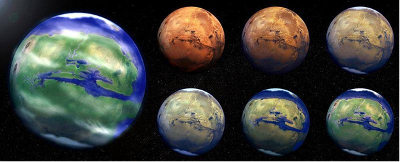Terraforming is the theoretical process of altering a planet, moon, or other astronomical body to make it similar to Earth and capable of supporting Earth-like life. The process would involve transforming the atmosphere and climate of an extraterrestrial body to make it hospitable to human life. While science fiction authors have long portrayed terraforming, scientists began seriously exploring the concept in the 1960s. Advocates cite space colonization as an inevitability, due to human population growth and demand for limited resources. Colonizing other areas of space would also increase the odds of human survival if a large asteroid strike or other major disaster were to affect Earth.
In order to be considered a candidate for terraforming, an astronomical body would need to have enough mass and gravity to hold an atmosphere. In addition, NASA’s criteria for planetary habitability includes "extended regions of liquid water, conditions favorable for the assembly of complex organic molecules, and energy sources to sustain metabolism.”
 Terraforming would take place in multiple stages. The first stage would involve importing oxygen-producing microbes and algae that can exist under extreme conditions. The oxygen these organisms release would begin the slow process of generating a breathable atmosphere. As the atmosphere evolves and conditions become more hospitable, plant life could be also be introduced. The plants would accelerate oxygen production, eventually rendering the atmosphere capable of supporting animals.
Terraforming would take place in multiple stages. The first stage would involve importing oxygen-producing microbes and algae that can exist under extreme conditions. The oxygen these organisms release would begin the slow process of generating a breathable atmosphere. As the atmosphere evolves and conditions become more hospitable, plant life could be also be introduced. The plants would accelerate oxygen production, eventually rendering the atmosphere capable of supporting animals.
Mars is the most Earth-like planet in our solar system, and scientists believe it once had running water and a thicker atmosphere than it does today. While much of the atmosphere and water was eventually lost over hundreds of millions of years, scientists believe that the planet could once again sustain these resources. It is currently considered the best candidate for terraforming for these reasons.
Terraforming Mars would mainly involve building up its very thin atmosphere and increasing surface temperatures. Researchers have suggested releasing the carbon dioxide locked in the Martian crust back into the atmosphere to trigger a greenhouse effect that would warm the planet. Another option would be to manufacture chlorofluorocarbons from chemicals in the air and soil, then release them into the atmosphere.
The rising temperatures would eventually be capable of melting the Martian ice. Once Mars begins to thaw and a sufficient amount of liquid water becomes available, trees could be planted. The trees would further accelerate the conversion of carbon dioxide to oxygen. Oxygen could also be extracted from the water and chemicals present in the Martian soil. The new atmosphere could remain for many thousands of years, or possibly be replenished as needed.
Estimates for the amount of time it would take to terraform Mars range from a few decades to hundreds of years. While scientists believe that some methods of terraforming Mars may be technically possible at present, the financial and natural resources required for such a feat would be massive, and are currently prohibitive. Differences in surface gravity between the two planets could also present difficulties; colonists might experience physiological changes and adverse health effects as a result of living in an environment that has less than half the gravity of Earth.
Photo credit: Mars terraforming. By Dmytr0 (Own work) [CC BY-SA 4.0], via Wikimedia Commons